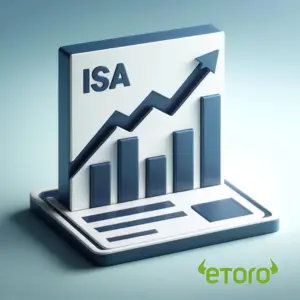Quick Answer
To short an asset on eToro: Log in and ensure your account is funded. Use the search tool to find your desired asset, select ‘Trade,’ then ‘SELL’ to initiate a short sale. Enter investment details, set stop loss, take profit, choose leverage, and click ‘Open Trade’ to execute
Introduction
One of the great strengths of eToro is its versatility in trading a variety of assets. Learn more here about what eToro is and how it works.. On this platform, you can engage not only in ‘long’ positions to leverage rising prices but also in ‘short’ positions to profit from declines in asset prices. If you’re keen to learn how to short sell on eToro, this guide is tailored for you.
What is Shorting?
Shorting, or short selling, is an investment strategy used when an investor anticipates a decline in the price of an asset. It involves borrowing an asset, such as a stock, and selling it at its current market price. Later, the investor buys back the asset at a lower price, returns it to the lender, and pockets the difference as profit. This strategy contrasts with traditional investing, where profits are made through buying low and selling high.
However, if the price goes up instead, you lose money. The potential losses in short selling are theoretically unlimited, unlike traditional buying where your loss is limited to your investment amount.
How to Short Sell on eToro
Short selling on eToro is straightforward. Follow these steps to get started:
- Accessing Your Account: Log into your eToro account.
- Funding: Ensure your account has adequate funds for trading.
- Asset Selection: Locate the asset you intend to short using the search tool.
- Initiating a Short Sale: Select the ‘Trade’ option and then choose ‘SELL’ to open a short position.
- Setting Trade Parameters: Enter the amount you wish to invest or specify the number of units. Set your risk management controls, including stop loss and take profit points.
- Leverage: Choose a leverage level that suits your trading strategy.
- Executing the Trade: Click on ‘Open Trade’ to finalize the transaction.
These steps allow you to capitalize on falling asset prices on eToro, offering a way to diversify your trading strategies and potentially increase your returns, especially in bearish market conditions. As always, remember that trading involves risks, and it’s crucial to manage your investments prudently.
Which Securities Can You Short on eToro?
While eToro offers a variety of tradable assets, short selling functionality is not available for all. Here’s a breakdown:
- Stocks: You can short sell individual stocks listed on various exchanges.
- Some ETFs: Not all ETFs are available for shorting, so be sure to check eToro’s availability for specific ones.
- Commodities: Certain commodities like gold, oil, or natural gas can also be shorted on eToro using CFDs (Contracts for Difference).
Currently, eToro does not support short selling on Cryptocurrency or Forex (Foreign Exchange)
How Shorting Works on eToro
Forget borrowing actual shares! Shorting on eToro is streamlined compared to traditional methods. Here’s the breakdown:
- CFDs: Your Shortcut to Shorting: Unlike traditional short selling where you borrow shares, eToro uses Contracts for Difference (CFDs). Think of them as contracts that mirror the price movement of an asset (like a stock) without you actually owning it. This allows you to speculate on price movements in both directions – up or down.
- Profiting from Downturns: If you believe a stock price will decline, you can open a SELL position using CFDs. If the price falls as expected, you can buy back the CFDs at a lower price and pocket the difference (minus fees).
However, if the price goes up, you’ll incur losses. Unlike buying stocks where your loss is limited to your investment, short selling losses can theoretically be unlimited.
Beyond CFDs: Alternative Shorting Options
While CFDs are the primary method for shorting on eToro, there are a couple of additional options:
- Inverse ETFs: These exchange-traded funds are designed to deliver the opposite return of an underlying index. So, if you invest in a short QQQ ETF that tracks the Nasdaq 100 but it goes down, you potentially profit.
- Short-ETFs Smart Portfolios: eToro offers pre-built portfolios containing short positions on major global ETFs. These portfolios are designed to increase in value if the prices of the underlying ETFs fall.
What are the costs for shorting on eToro?
When short selling on eToro, you’ll encounter a few types of costs that can affect the profitability of your trades:
- Spread Costs: This is the difference between the buy (ask) and sell (bid) price of the asset. For instance, if you’re shorting a stock where the sell price is £100 and the buy price is £100.20, the spread cost is £0.20 per share.
- Overnight Fees: These are charges for holding a position open overnight. For example, if you hold a short position on a stock, you may pay a small fee based on the value of the position. This fee compensates for the credit risk and the cost of the capital used during the time you hold the trade open.
- Commission Fees: eToro typically offers commission-free trading on stocks, but trading other assets like cryptocurrencies or CFDs might incur a commission. Always check the specific asset’s fee structure on the platform.
- Leverage Costs: When using leverage, you’re essentially borrowing money to increase your trading position. For example, if you short sell using 2X leverage, and the leverage fee is 0.03% daily, your cost will increase proportionally to the leverage applied.
Being aware of these costs and how they might impact your trading outcomes is crucial for effective financial planning and risk management when engaging in short selling on eToro.
What are the pros and cons of shorting on eToro?
- Profit from Price Drops: Ability to earn profits from falling asset prices, not just from increases.
- Market Diversification: Provides options to trade against the market trend, offering a hedge against long positions.
- Access to Global Markets: Short sell a wide range of assets including stocks, cryptocurrencies, and more from various global markets.
- Integrated Tools: Use of advanced trading tools like stop loss and take profit to manage risks effectively.
- Reputable and Trusted
- Risk of Unlimited Losses: Potential losses can exceed the initial investment if the asset’s price rises.
- Interest Costs: Holding a short position might incur overnight financing costs, depending on the asset and market conditions.
- Market Volatility: Short selling is highly susceptible to market volatility, which can lead to rapid, significant losses.
- Regulatory and Liquidity Risks: Certain assets may have restrictions or limited liquidity, complicating the execution of short sales.
Summary
Short selling on eToro offers traders the opportunity to capitalize on declining market prices and adds a robust layer to investment strategies. It comes with its unique set of advantages such as market access and advanced trading tools, but also significant risks like potential for unlimited losses and susceptibility to market volatility. Costs associated with short selling, such as spreads and overnight fees, must also be considered to ensure a comprehensive trading approach. By leveraging eToro’s user-friendly platform and its features, investors can navigate the complexities of short selling with greater insight and preparedness. Always consider consulting with a financial advisor to tailor your investment strategies to your personal risk tolerance and financial goals.
Key Takeaways
- Short selling on eToro lets you profit if a stock price falls, but with significant risks. Unlike regular buying, losses can be unlimited.
- EToro uses CFDs (Contracts for Difference) for shorting. You don’t borrow actual shares, but contracts that mirror price movements.
- Key steps for shorting on eToro: * Research and pick a stock you think will decline. * Open a SELL position using CFDs. * Consider setting stop-loss and take-profit orders to manage risk. * Monitor your position and close it by buying back CFDs at a lower price (ideally).
- Alternatives to short selling on eToro: * Put options: Grant the right, but not the obligation, to sell a stock at a specific price by a certain date, limiting your loss. * Inverse ETFs: Designed to deliver the opposite return of an underlying index, potentially profiting if the index falls.
- Costs associated with short selling on eToro: * Spreads (platform fees). * Overnight financing fees (for holding CFDs overnight). * Margin interest (if using leverage).
- Short selling is complex and for experienced investors only. Conduct thorough research, understand the risks, and prioritize responsible trading practices.

CFDs are complex instruments with a high risk of losing money rapidly due to leverage. {etoroCFDrisk}% of retail CFD accounts lose money when trading CFD’s with this provider. You should consider whether you understand how CFDs work and whether you can afford to take the high risk of losing your money.
Frequently Asked Questions
What is short selling on eToro?
Short selling on eToro is an investment strategy where traders borrow and sell assets they anticipate will decrease in value. The goal is to buy these assets back at a lower price, return them to the lender, and profit from the price difference.
How do I start short selling on eToro?
To start short selling on eToro, log into your account, ensure it is funded, find the asset you wish to short, click ‘Trade’, select ‘SELL’, enter your investment details, set your risk management parameters, decide on your leverage, and then open the trade.
What assets can I short sell on eToro?
On eToro, you can short sell a variety of assets, including stocks, cryptocurrencies, ETFs, indices, and commodities. This allows for a diverse range of trading strategies and opportunities.
What are the risks of short selling on eToro?
The risks of short selling on eToro include unlimited potential losses if the asset’s price rises, interest costs for holding a position overnight, high market volatility, and the regulatory and liquidity risks associated with certain assets.
What fees are involved in short selling on eToro?
Fees for short selling on eToro include spread costs, overnight fees for positions held longer than a day, and potentially commission fees depending on the asset. If using leverage, additional fees may apply, increasing the total cost of the trade.
Disclaimer –
eToro is a multi-asset platform which offers both investing in stocks and cryptoassets, as well as trading CFDs.
Please note that CFDs are complex instruments and come with a high risk of losing money rapidly due to leverage. 51% of retail investor accounts lose money when trading CFDs with this provider. You should consider whether you understand how CFDs work, and whether you can afford to take the high risk of losing your money.
This communication is intended for information and educational purposes only and should not be considered investment advice or investment recommendation. Past performance is not an indication of future results.
Copy Trading does not amount to investment advice. The value of your investments may go up or down. Your capital is at risk.
Don’t invest unless you’re prepared to lose all the money you invest. This is a high-risk investment and you should not expect to be protected if something goes wrong. Take 2 mins to learn more eToro USA LLC does not offer CFDs and makes no representation and assumes no liability as to the accuracy or completeness of the content of this publication, which has been prepared by our partner utilizing publicly available non-entity specific information about eToro.
Gain Access to Our #1 Recommended Investment Platform in the UK
{etoroCFDrisk}% of retail CFD accounts lose money.
More From eToro
References
eToro. (n.d.). What Is Short Selling and How Does It Work? https://www.etoro.com/news-and-analysis/trading/short-selling/ Retrieved 17/05/2024 from https://www.etoro.com/news-and-analysis/trading/short-selling/
















